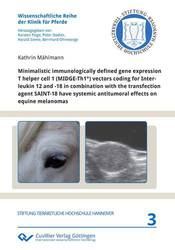| Areas | |
|---|---|
| Serie de libros (96) |
1378
|
| Nachhaltigkeit |
3
|
| Gesundheitswesen |
1
|
| Letra |
2365
|
| Ciencias Naturales |
5406
|
| Matemática | 229 |
| Informática | 319 |
| Física | 980 |
| Química | 1363 |
| Geociencias | 131 |
| Medicina humana | 243 |
| Estomatología | 10 |
| Veterinaria | 108 |
| Farmacia | 147 |
| Biología | 835 |
| Bioquímica, biología molecular, tecnología genética | 121 |
| Biofísica | 25 |
| Nutrición | 45 |
| Agricultura | 1004 |
| Silvicultura | 201 |
| Horticultura | 20 |
| Ecología y conservación de la tierra | 148 |
| Ciencias Ingeniería |
1793
|
| General |
98
|
|
Leitlinien Unfallchirurgie
5. Auflage bestellen |
|
Erweiterte Suche
Minimalistic immunologically defined gene expression T helper cell 1 (MIDGE-Th1®) vectors coding for Interleukin 12 and -18 in combination with the transfection agent SAINT-18 have systemic antitumoral effects on equine melanomas (Volumen 3) (Tienda española)
Kathrin Mählmann (Autor)Previo
Indice, PDF (54 KB)
Lectura de prueba, PDF (180 KB)
Equine melanomas are the most common neoplasms in older grey horses. Until now, no curative therapy is established. Xenogenic DNA vaccination represents a promising therapeutic approach.
Goal of the present study was to evaluate the safety and clinical efficacy of vaccination of grey horses with natural occurring melanomas with MIDGE-Th1® vectors encoding for equine (eq) IL12 and eqILRAP-IL18 alone or in combination with human gp100 (hgp100) or human tyrosinase (htyr).
Three groups (each n=9) of adult grey horses with variable numbers of melanomas received three intramuscular and three intradermal peritumoral vaccinations. Each group was treated with MIDGE-Th1® vectors coding for eqIL12 and eqILRAP-IL18. One group (group gp100) was additionally treated with 500 μg hgp100MIDGE-Th1® and one group with 500 μg htyrMIDGE-Th1® (group tyr). The third group did not receive additional DNA (group IL12/18). Vectors were complexed with the transfection agent SAINT-18.The injections were performed on days 1, 22 and 78 intradermally around one selected melanoma (locally treated melanoma) and intramuscularly as a systemic treatment. A general examination of the horses and evaluation of local reactions at the injection site were performed daily during hospitalisation (on the day of each injection and 3 days after each injection as well as on day 120). In each horse the locally treated melanoma and up to 8 non-locally treated melanomas were measured before each injection and on day 120 by calliper and ultrasound. The relative volumes were calculated in relation to day 1 (100%).
For the evaluation of the generation of specific CD8+ cytotoxic T-cells against hgp100 and htyr, peripheral blood mononuclear cells (PBMCs) isolated before each injection and on day 120, were stimulated in vitro with autologous dermal cells transfected with hgp100 or htyr. Interferon γ (IFN γ) as a response to this specific stimulation was measured by intracellular immunofluorescence staining.
Specific serum antibodies against hgp100 and htyr were measured at equivalent time points as cytotoxic T-cells using a cell based flow cytometric assay. Human embryonic kidney cells, transfected with hgp100 or htyr served as a source for antigens.
The only consistent abnormal finding upon clinical examination of the treated horses was an increased body temperature. A significant increase in body temperature (38.7 ± 0.59 °C) was recorded after 40 of the 81 injections, and usually lasted for one day. Local inflammatory reactions and depigmentation were observed in all groups starting at day 3 after the first application.
The relative tumor volume (%) was significantly reduced to 71.5 ± 29.73% (calliper measurements) and 87.0 ± 24.42% (ultrasound measurements). There were no significant differences detected between groups (gp100, tyr and IL12/18). No difference was seen in reduction of tumor volume between locally treated and non-locally treated melanoma.
Neither a cellular nor a humoral immune response against the vaccine antigens could be detected.
In this study, treatment with eqIL12 and eqILRAP-IL18 DNA in combination with SAINT-18 showed a systemic effect against grey horse melanoma. There was no additional clinical or immunological effect observed by vaccination with MIDGE-Th1® vectors encoding hgp100 and htyr. It remains unclear whether the antitumoral effect was caused by the interleukins, unmethylated CpG motifs or the induction of an immune reaction by the combination of DNA and transfection reagent.
Reasons for the absence of a specific immune response may be an inadequate selection of dosages or treatment interval. It is also possible that the sensitivity of the immunoassays was too low to detect a subclinical immune response.
Further studies to characterize the antitumoral effects of the treatment used in this study and modifications of the treatment protocol to achieve a potential specific immune response are warranted.
| ISBN-13 (Impresion) | 9783954042753 |
| ISBN-13 (E-Book) | 9783736942752 |
| Formato | A5 |
| Idioma | Inglés |
| Numero de paginas | 192 |
| Laminacion de la cubierta | mate |
| Edicion | 1. Aufl. |
| Serie | Wissenschaftliche Reihe der Klinik für Pferde |
| Volumen | 3 |
| Lugar de publicacion | Göttingen |
| Lugar de la disertacion | Hannover |
| Fecha de publicacion | 23.11.2012 |
| Clasificacion simple | Tesis doctoral |
| Area |
Veterinaria
|
| Palabras claves | Spezielle Veterinärmedizin, SAINT-18, Equine, Melanoma, Xengenic, DNA vaccination |








